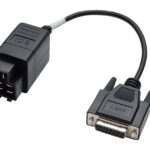Experiencing issues connecting your OBD2 scanner to your 2009 Honda Pilot can be frustrating, especially when you’re trying to diagnose a Check Engine Light or perform routine maintenance. A non-communicating OBD2 port prevents you from accessing crucial diagnostic information, hindering your ability to understand your vehicle’s health. This guide will walk you through common reasons why your OBD2 scanner might not be connecting to your 2009 Honda Pilot and provide troubleshooting steps to get you back on track.
Common Causes for OBD2 Connection Failure
Several factors can contribute to an OBD2 port not connecting. Let’s explore the most frequent culprits:
1. Faulty OBD2 Scanner or Cable
The simplest explanation is often overlooked. Your OBD2 scanner itself or the cable connecting it to your Honda Pilot’s port could be defective.
- Scanner Malfunction: The internal electronics of your scanner might be malfunctioning. Try using the scanner on another vehicle to see if it connects. If it fails to connect elsewhere, the scanner is likely the issue.
- Cable Damage: Inspect the OBD2 cable for any visible damage like cuts, frayed wires, or bent pins. A damaged cable can disrupt the communication signal. Try a different, known-good OBD2 cable to rule this out.
2. Blown Fuse
The OBD2 port in your 2009 Honda Pilot is powered by a fuse. If this fuse blows, the port will lose power and become non-functional.
- Locate the Fuse Box: Consult your Honda Pilot owner’s manual to find the location of the fuse box(es). There are typically fuse boxes under the dashboard and in the engine compartment.
- Identify the OBD2 Fuse: Refer to the fuse box diagram in your owner’s manual to identify the fuse responsible for the OBD2 port or the “diagnostic port,” “accessory power,” or similar description.
- Inspect and Replace: Visually inspect the fuse. A blown fuse often has a broken wire inside. Even if it looks intact, it’s best to test it with a multimeter or replace it with a fuse of the same amperage rating.
3. OBD2 Port Damage or Corrosion
The OBD2 port itself can suffer physical damage or corrosion, preventing proper connection.
- Visual Inspection: Carefully examine the OBD2 port under the dashboard. Look for bent or broken pins inside the port. Also, check for any signs of corrosion, dirt, or debris that might be obstructing the connection.
- Cleaning the Port: If you see dirt or corrosion, gently try cleaning the port with compressed air or a soft brush. Be careful not to damage the pins. For corrosion, you might use a specialized electrical contact cleaner, but ensure it’s safe for automotive electronics.
4. Wiring Issues
Problems in the wiring harness connecting the OBD2 port to the vehicle’s computer system can interrupt communication.
- Wiring Harness Damage: Check the wiring harness leading to the OBD2 port for any signs of damage, such as cuts, crimps, or rodent damage.
- Loose Connections: Ensure the OBD2 port is securely mounted and that the wiring connectors behind it are firmly attached. Loose connections can cause intermittent or complete communication failure.
5. ECU/PCM Problems
In rare cases, a problem with the Engine Control Unit (ECU) or Powertrain Control Module (PCM) itself could be preventing OBD2 communication. However, this is usually accompanied by other significant vehicle performance issues.
- ECU/PCM Faults: If you’ve ruled out all other possibilities, and your vehicle is exhibiting other electrical or engine management problems, there’s a chance the ECU/PCM is faulty. This is a more complex issue requiring professional diagnosis.
Troubleshooting Steps for OBD2 Connection Issues
Follow these steps to systematically troubleshoot the OBD2 connection problem on your 2009 Honda Pilot:
- Verify Scanner Function: Test your OBD2 scanner on a different vehicle to confirm it’s working correctly.
- Check the Cable: Try a different OBD2 cable that you know is functional.
- Inspect the OBD2 Port Fuse: Locate and check the fuse for the OBD2 port. Replace it if blown.
- Visually Examine the OBD2 Port: Look for damage, bent pins, or corrosion in the port. Clean if necessary.
- Inspect Wiring: Check the wiring harness and connections leading to the OBD2 port for damage or looseness.
- Consult a Professional: If you’ve gone through these steps and still cannot connect, it’s time to consult a qualified mechanic. They have specialized tools and knowledge to diagnose more complex electrical issues, including potential ECU/PCM problems.
Conclusion
A non-connecting OBD2 port on your 2009 Honda Pilot can be a roadblock to vehicle diagnostics. By systematically checking the scanner, cable, fuse, port condition, and wiring, you can often identify and resolve the issue. Remember to consult your owner’s manual for fuse box locations and diagrams. If you’re uncomfortable working with electrical systems or the problem persists, seeking professional help is always the best course of action to ensure accurate diagnosis and repair.
